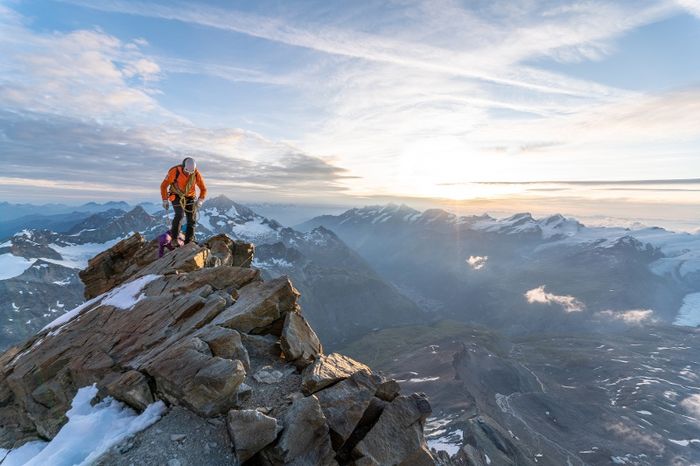Jan Beutel ETH Zurich
–
Samuel Weber installed a seismometer and solar panels on the top of the Matterhorn.
–
Nationalgeographic.co.id—Seismic energy from the Earth can generate vibrations in the great mountains continuously, even though the mountains seem immovable. amplification seismic energy The steep topography has played an important role in controlling the location of landslides caused by earthquakes.
The Alps represent extreme topography. Therefore significant amplification can be anticipated. However, the relevant data needed to investigate the boundary of topographical effects at this location is sparse.
An international research team has now been able to measure the resonance wobble Matterhorn in the Swiss Alps and made his movements visible using computer simulations.

Weber S. dkk, 2021
–
Graph of the two types of vibrations in the Matterhorn: The top of the mountain shows the greatest deflection, the foot of the mountain only the minimal.
–
Matterhorn emerged as a great immovable mountain, towering over the landscape near Zermatt for thousands of years. A study published in the journal Earth and Planetary Science Letters on December 22, 2021 entitled Spectral amplification of ground motion linked to resonance of large-scale mountain landforms, has shown that this impression is wrong. An international team of researchers have proven that the Matterhorn is in fact constantly in motion, swinging gently back and forth about once every two seconds. These subtle vibrations of usually imperceptible amplitude are stimulated by seismic energy on Earth from the world’s oceans, earthquakes, and human activity.
“Subterranean movement causes every object to vibrate, which fortunately we can’t feel, but which can be detected with sensitive measuring instruments,” said Donat Fäh of the Swiss Seismological Service at ETH Zurich.
These so-called natural frequencies mainly depend on the geometry of the object and its material properties. This phenomenon is also seen in bridges, high-rise buildings, and even mountains.
“We wanted to know if such resonant vibrations could also be detected in a large mountain like the Matterhorn,” said Samuel Weber. He did his studies during his postdoctoral period at the Technical University of Munich (TUM) and now works at the WSL Institute for SLF Snow and Avalanche Research. He emphasized that the interdisciplinary collaboration between researchers at the Swiss Seismological Service at ETH Zurich, the Institute of Computer Engineering and Communication Networks at ETH Zurich, as well as the Geohazard Research Group at the University of Utah (USA) was critical to the success of this project.
Scientists installed several seismometers on the Matterhorn for research, including one directly on the summit at 4,470 meters above sea level and another on the Solvay bivouac, a makeshift shelter on the northeast ridge, better known as Hörnligrat.
Another measuring station at the foot of the mountain serves as a reference. The extensive experience of Jan Beutel (ETH Zurich / University of Innsbruck) and Samuel Weber installing equipment to measure rock movement in high mountains makes this network of measurements possible. Data is automatically transmitted to the Swiss Seismological Service.
The seismometer recorded all of the mountain’s motion at high resolution, so the team was able to obtain the frequency and direction of the resonance. Measurements show that the Matterhorn oscillates roughly in a north-south direction at a frequency of 0.42 Hertz and in an east-west direction at a second equal frequency (see animation). In turn, by speeding up vibration measurements by about 80 times, the team was able to make the Matterhorn’s vibrational landscape audible to the human ear, translating the resonant frequency into an audible pitch. Extraordinary!

Gabriel Perren, Zermatt Tourism
–
Stunning Matterhorn panorama.
–
Jeff Moore of the University of Utah, who initiated the study of the Matterhorn, explains: “Mountain areas that experience amplified ground motion tend to be more susceptible to landslides, rockfall, and rock damage when shaken by a strong earthquake.”
Such tremors are not unique to the Matterhorn, and the team noted that many mountains are expected to vibrate in the same way. Researchers from the Swiss Seismological Service conducted a complementary experiment at Grosse Mythen as part of the study.
Also Read: Latest Science, Scientists Reveal Our Earth May Have a Fifth Layer
This peak in Central Switzerland is similar to the Matterhorn but significantly smaller. As expected, the Grosse Mythen vibrates at a frequency about four times higher than the Matterhorn because smaller objects generally vibrate at a higher frequency. Scientists from the University of Utah were then able to simulate the resonances of the Matterhorn and Grosse Mythen on a computer that made these resonant vibrations visible.
Previously, US scientists had primarily studied smaller objects, such as the rock arch in Arches National Park, Utah. “It’s great to see that our simulation approach also works for large mountains like the Matterhorn and the measurement data confirms the results,” said Jeff Moore.
Also Read: 1,300 years ago Pangandaran and Cilacap were hit by a tsunami
PROMOTED CONTENT
Featured Videos
– .


